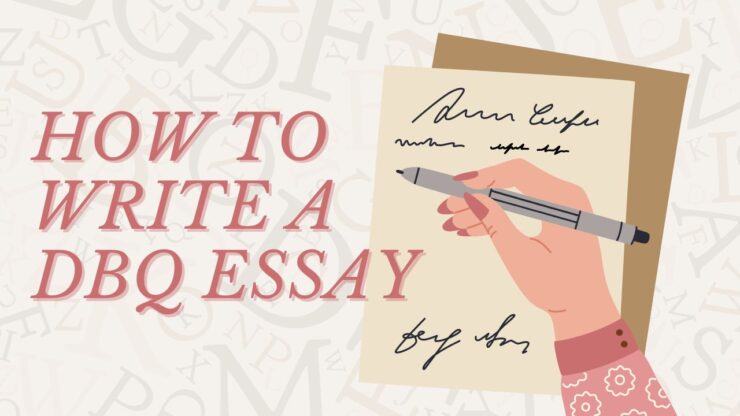If you’ve ever faced the daunting task of writing a DBQ (Document-Based Question) essay, you’re not alone. This type of essay is often required in Advanced Placement (AP) History exams and other similar history courses and can be a challenge for many students. Fear not! With the right guidance, writing a DBQ essay can become a manageable and even enjoyable task.
In this comprehensive guide, we’ll break down the process of writing a DBQ essay into simple steps, provide examples, and share tips that will help you craft a top-notch essay. By the end of this article, you’ll have all the tools you need to impress your instructors and ace that DBQ essay!
Overview of the DBQ Essay
Before diving into the writing process, it’s important to understand what a DBQ essay is and why it’s used. A DBQ essay is a type of essay that requires you to analyze historical documents and use them as evidence to support your thesis. The purpose of a DBQ essay is to evaluate your ability to:
- Analyze historical documents and extract relevant information
- Develop a clear and coherent thesis statement
- Support your thesis with historical evidence and analysis
- Demonstrate an understanding of historical context and the ability to make connections between events
- Organize and present your arguments in a logical and persuasive manner
Now that we have a clear understanding of the DBQ essay, let’s move on to the step-by-step guide to writing a successful one.
Step-by-Step Guide to Writing a DBQ Essay

1. Analyze the Prompt
The first step in writing a DBQ essay is to carefully read and analyze the prompt. The prompt will provide you with a specific historical question or theme that you’ll need to address in your essay. To do this effectively, you should:
- Read the prompt multiple times, highlighting or underlining keywords and phrases.
- Identify the specific historical question or theme you need to address.
- Determine what kind of evidence or analysis will be required to answer the question or address the theme.
2. Read and Understand the Documents
Once you have a clear understanding of the prompt, you’ll need to read and analyze the documents provided. These documents will serve as the foundation for your essay, providing you with historical evidence to support your thesis. As you read the documents, keep the following in mind:
- Identify the main idea or argument of each document.
- Determine how each document relates to the prompt and your thesis.
- Take note of any important dates, events, or historical figures mentioned in the documents.
- Consider the point of view, purpose, and historical context of each document.
3. Plan Your Essay
After analyzing the documents, you’ll need to plan your essay. This is a crucial step, as a well-organized essay will be much easier to write and more likely to earn a high score. To plan your essay, you should:
- Develop a clear and concise thesis statement that directly addresses the prompt.
- Organize the documents into groups based on their main ideas or arguments.
- Determine which documents will best support your thesis and how they relate to one another.
- Create an outline for your essay that includes an introduction, body paragraphs, and a conclusion. Each body paragraph should focus on a specific group of documents and the main idea or argument they support.
4. Write Your Essay

With a solid plan in place, you’re ready to write your DBQ essay. Follow your outline and keep these guidelines in mind as you work through each section.
1. Introduction
In the introduction, you’ll need to:
- Provide a brief overview of the historical context surrounding the prompt.
- Clearly state your thesis statement, directly addressing the prompt.
- Preview the main points or arguments you’ll discuss in your body paragraphs.
2. Body Paragraphs
Each body paragraph should focus on one main idea or argument supported by a group of documents. To write effective body paragraphs, be sure to:
- Begin each paragraph with a clear topic sentence that relates to your thesis.
- Introduce and analyze the relevant documents, explaining how they support your thesis.
- Use specific examples and quotes from the documents as evidence.
- Discuss the point of view, purpose, and historical context of the documents, demonstrating your understanding of their significance.
- Make connections between the documents, showing how they relate to one another and to your thesis.
3. Conclusion
In conclusion, you’ll want to:
- Restate your thesis in a new way, summarizing your main points or arguments.
- Briefly discuss the broader implications of your analysis, connecting your findings to the larger historical context.
- Leave your reader with a lasting impression by ending on a strong, thought-provoking note.
Tips for Success
As you work on your DBQ essay, keep these tips in mind for a smoother writing process and a higher score:
1. Thoroughly Analyze the Prompt
Taking the time to carefully analyze the prompt will ensure that you address the specific question or theme presented. Be sure to identify the keywords and phrases in the prompt, and think about the type of evidence or analysis that will be required to respond to it effectively.
2. Manage Your Time Wisely

A crucial aspect of successfully writing a DBQ essay is managing your time effectively. Allocate your time wisely, giving yourself enough time to analyze the prompt and documents, plan your essay, and write a well-organized response. Be mindful of the time limit and pace yourself accordingly.
3. Read and Understand the Documents
Take the time to thoroughly read and analyze each document. Make notes of key points, historical figures, and relevant events. Consider the point of view, purpose, and historical context of each document, and think about how they relate to the prompt and your thesis.
4. Use a Variety of Documents
To demonstrate your understanding of the historical context and the complexity of the issue, use and analyze as many documents as possible in your essay. This will provide strong evidence for your arguments and showcase your ability to synthesize information from various sources.
5. Stay Focused on Your Thesis
Always connect your arguments and analysis back to your thesis statement. This will ensure that your essay remains coherent and focused throughout. Your thesis should act as a guide, helping you to determine which documents and pieces of evidence are most relevant to your argument.
6. Develop a Clear and Detailed Outline
Before you begin writing your essay, create a detailed outline that organizes your main points and evidence. This will help you stay on track as you write and ensure that your essay is well-structured and easy to follow.
7. Practice Writing Concise Topic Sentences
Strong topic sentences are essential for effective body paragraphs. Make sure your topic sentences clearly express the main idea or argument of the paragraph and relate back to your thesis statement. This will help guide your reader through your essay and make your arguments easier to understand.
8. Use Specific Evidence and Analysis
When discussing the documents, use specific examples and quotes as evidence to support your arguments. Analyze the documents carefully, explaining how they support your thesis and demonstrate your understanding of their significance within the historical context.
9. Make Connections Between Documents
Showcase your ability to synthesize information by making connections between the documents and how they relate to one another and to your thesis. This will help you create a more cohesive and persuasive argument.
10. Revise and Edit
After completing your initial draft, take the time to revise and edit your essay. Check for clarity, organization, and grammatical errors. Make sure your arguments are well-supported and that your essay flows smoothly from one point to the next.
11. Practice, Practice, Practice
The more DBQ essays you write, the more comfortable you’ll become with the process and the better your essays will be. Practice writing DBQ essays on various topics to develop your skills and gain confidence in your ability to tackle any DBQ essay prompt.
Closing Thoughts
Writing a DBQ essay can be a challenging task, but with the right guidance and practice, it can become a manageable and even enjoyable process. By following the steps outlined in this comprehensive guide, analyzing the documents carefully, planning your essay, and employing the tips for success, you’ll be well on your way to crafting a top-notch DBQ essay that impresses your instructors and earns you a high score. So go forth and conquer that DBQ essay with confidence!

